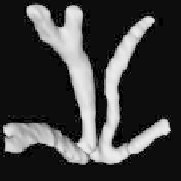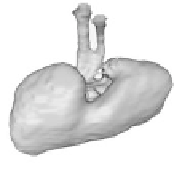Biomedical Engineering Reference
In-Depth Information
(a)
(b)
(c)
Figure 7.16:
Extracted surfaces for: (a) artery data set; ( b) artery2; and (c) kid-
ney data set.
The number of I/O operations is a problem that we must address in future
works. If we compare the “no. of I/O” with the number of meta-cells that the
T-surfaces cuts during evolution (cutMC, in row 3), we observe that we should
look for more efficient schemes for memory management.
The parameters used in the T-surfaces for the above experiments are: grid 4
×
4
×
4, freezing point
=
10,
γ
=
0
.
01,
k
=
1
.
222,
c
=
0
.
750. The intensity pattern
of the targets is given by the following ranges: [10
,
22] for data set, [195
,
255] for
kidney, and [15
,
30] for artery2. Figure 7.16 shows the extracted surfaces.
The data set artery2 is a gray-level version of a volume obtained from the
Visible Human project. The ColorV data set, mentioned in Table 7.1, is the same
volume, but in its original color (RGB). We apply our method for this volume,
just using one threshold for each color channel [7] and using the color edge
definition given in Section 7.8.
The Visual Human project encompasses a huge color data set of human body.
For 125 meta-cells, we found R, G, and B interval trees with 64.75 kB, 65.67 kB
and 45.59 kB, respectively, given the total size of 176.01 kB reported in Table 7.1.
The preprocessing time is much higher now (29 min) due to the number of
operations required to compute the gradient.
7.10 Discussion and Perspectives
When considering automatic initialization for deformable models, some aspects
must be taken into account. The target topology may be corrupted due to inho-
mogeneities of the image field or gradient discontinuities. Besides, the obtained



